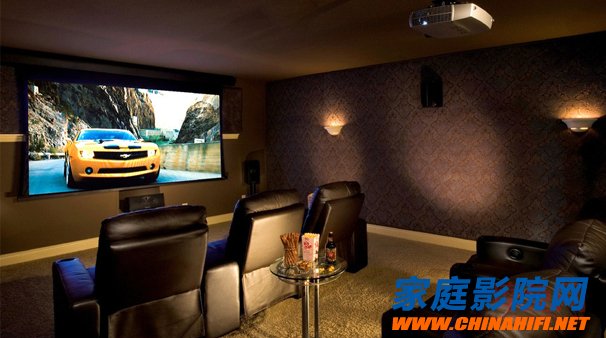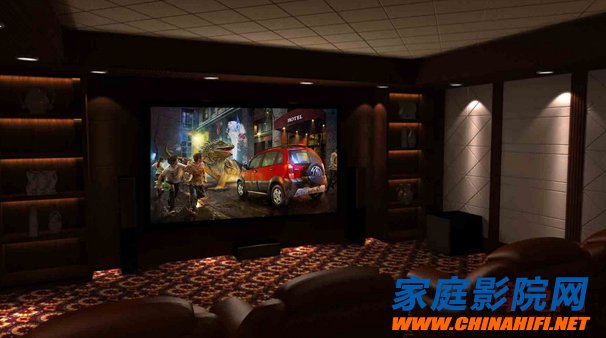Many people think that the decoration of the audio-visual room is not much different from the decoration of the ordinary room. This is a big misunderstanding. In addition to the difference in design style, the decoration of the audio-visual room should pay attention to the problem of acoustic decoration. It is the most common sound-absorbing and sound-absorbing treatment (see: How to deal with sound insulation and sound absorption in home theater). The following small series will give you a detailed introduction to the issues that must be paid attention to in the decoration design of the 4-point home theater audio-visual room.

1. Choose a reasonable in-wall audio and video cable
For most home audio-visual rooms, the use of in-wall wire installation is the only option. Due to the non-replaceability of the wire in the short term, it is essential to spend more money to select high-quality wire. HDMI cable will be the main audio and video transmission medium in the future. High-quality HDMI cable that meets at least the requirements of version 1.4 is indispensable, and even if budget allows, it is even recommended to lay two HDMI cables and make video with each other. Transfer redundant backups. The embedding of audio cables is relatively simple. Follow the principle of one in the end and not indifferent. Use high-quality audio cables with more than 300 cores to bury them in the position where you need to place or wall-mounted speakers.
The pure power supply plays a very important role in the excellent performance of the audio-visual room system equipment. As far as possible, it provides a separate wall seat for each electronic equipment in the audio-visual room. If the requirements are stricter, the power distribution line from the household is provided. Pulling a separate power supply line to the audio-visual room (best-core copper cable with a cross-sectional area of ​​20mm2 or more is the best) can effectively improve the interference generated by the sudden start of other high-current equipment in the home network. It is the electronic equipment in the audio-visual room that has a very good current supply.

2. Choose to handle the wall color and minimize the effect of indoor light reflection on the video effect.
Under the action of the light bulb, the projector projects a video image onto the screen to form a picture. After the light emitted from the projector is projected onto the surface of the screen, it will also reflect and diffuse to the wall near the screen, and the light passes through the wall again. The reflection of the surface, some of which may enter the viewer's eyes, and the other part may be reflected to the projection screen again. In order to achieve the best viewing effect, it is necessary to find ways to eliminate the effect of the diffused or reflected light on the image. Interference.
In fact, looking at the practice of the cinema, it is very simple to solve this problem. Use a wall paint or wallpaper that is all black or nearly black (such as dark green) around the projection screen to keep the surface of the wall rough. can.

3. Sound insulation problems of the audio-visual room to the outside world
Sound insulation is actually a double meaning: the sound in the audio-visual room is not allowed to pass out, and the external sound is not allowed to be transmitted into the audio-visual room to affect the internal effect. The general method of sound insulation is first of all the treatment of the wall. The sound insulation of the wall is very simple. The wall surface can be used as the wooden keel + stuffed cotton + multi-layer gypsum board. The gypsum board can also be considered with a soundproof rubber pad to achieve good sound insulation. Followed by the handling of the door. The sound insulation of the door is slightly more complicated. If you choose the ordinary door that is sold in the market, you need to stick the soundproof felt + soundproof cotton and the outer wrap behind the door. You also need to seal the door cover with the same sealing and wrapping. The strip ensures that the door is tightly connected to the door sleeve for sound insulation. Therefore, it is possible to adopt a method of making a hollow solid wood door on the scene for the audio-visual room, and then internally filling the sound-absorbing cotton and wrapping the sound-absorbing felt on the outside. The sound absorption effect achieved in this way is better. Finally, the handling of the ceiling. The ceiling is a place that is easily overlooked in the soundproofing of the audio-visual room. The treatment method is relatively simple, and the wooden dragon skeleton can be added with sound-absorbing cotton.

4. Sound processing inside the audio-visual room
After completing the first three steps, you need to make a fine adjustment to the internal sound effects.
In the sound adjustment inside the audio-visual room, it is necessary to pay attention to adjusting the balance of the sound and the interference of the standing wave. The balance of the internal sound is adjusted so that the sound heard in the interior of the entire listening room, whether in the front or rear seats, does not change much. To do this, in a nutshell, use a sound absorbing panel at the reflection position where the front sound intensity is relatively large, and then add a diffusion plate at the rear and the top to achieve sound balance in the entire space.
Generally speaking, the sound absorbing panel is recommended to use a polyester fiber sound absorbing panel of 9 to 10 mm thick, and the substrate is made of ultra high density board; the diffusing board is recommended to adopt a fir material and strictly conform to the standard residue standard QRD diffusing plate. In addition to the use of the diffuser, the more diffused materials used on both sides of the wall, the back wall of the speaker, and the back wall of the listening position, the more you can feel the sense of space in the music venue. With the broad, extended natural and loose high-frequency performance, the details of the music can be greatly increased, and some of the weak dynamic changes that are usually difficult to detect are now as if they are vivid. If purely from the design and processing of audio-visual quality, the use of "diffusion" materials must be as good as possible, and have a good auxiliary effect on the improvement and improvement of sound.
The low frequency traps that need to be exploited for annoying standing waves. Standing waves are usually formed because sound waves are reflected between opposing faces in a closed room (the opposite faces are opposite walls, including left and right, front and back, and ceiling and floor). Stop the vibrating resident sound waves, they usually stay in the corner of the room. Therefore, we recommend that Mr. Zhang put a low-frequency trap (in fact, a box made of MDF filled with sound-absorbing cotton) in the corners of the room. The size and shape of the low-frequency trap determines the frequency at which it can be absorbed by the standing wave. This requires professional measurement and professional production. It is best to ask the professional audio-visual room design company to help measure and design. More home theater knowledge is available in China Home Theater Network, official WeChat: cnhifi.
Patrol Car,Highway Patrol Car,Security Patrol Car,Electric Security Patrol Car
Jinan Huajiang environmental protection and energy saving Technology Co., Ltd , https://www.hjnewenergy.com
